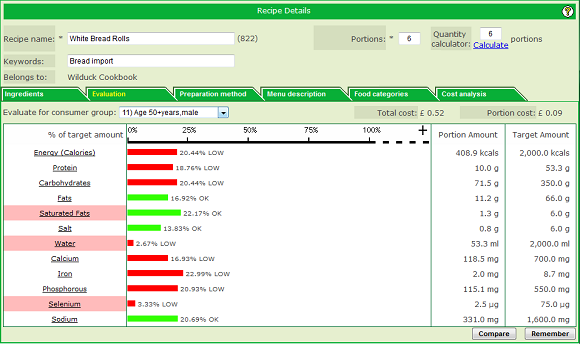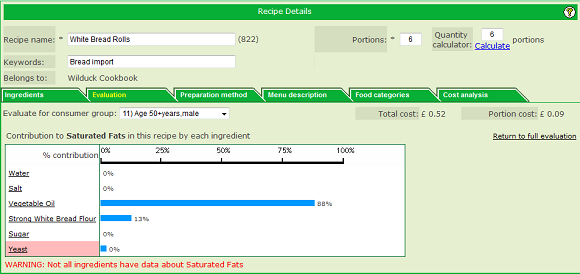

The evaluation tab of the recipe details page displays information about the nutritional content of ONE PORTION of the recipe.

Full details of how to interpret the information displayed in this section are provided in a dedicated tutorial topic, since it is relevant to the evaluation of recipes and to menus. However, this topic will discuss the relevance of an evaluation of a recipe.
When evaluating a single recipe, or more correctly, one portion of a single recipe, it is useful to see how well balanced the nutritional content is. In the above example the bar chart shows that, of the nutrients selected for display, listed down the left hand side (which ones are displayed are selected by your own preference selections), none of them stand out as particularly high.
Saturated fats, for example, can sometimes be present in large amounts in a recipe, especially where butter, cheese or cream are part of the recipe. The amount of salt in a recipe can also be something to monitor.
The chart provides a means of quickly assessing the nutritional content of a recipe to detect any areas that may be a concern so that some corrective action can be taken, such as reducing the quantity of an ingredient or using an alternate ingredient to reduce the amount of the problem nutrient.
To help identify which ingredient may be causing an excess of a nutrient, you can click on the nutrient name, Saturated Fats for example, and the system will then "drill down" into the recipe and display a breakdown showing the amount of the nutrient being contributed by each ingredient.

Here, for example, we have clicked on Saturated Fats and the system is showing us that the majority of the saturated fat in the recipe is contributed by the vegetable oil.
You will notice that the evaluation has been made for a particular "consumer group" (Age 50+ male in this case). The meaning of this is fully described in the dedicated nutritional evaluation topic. However, evaluating a single recipe against a consumer's daily guideline amount (allowance) is not particularly useful - people typically eat more than one recipe in a day. This type of evaluation, against a consumer group, is more relevant when evaluating menus or series of menus over a period of time.
However, as previously mentioned, the evaluation of a recipe helps to identify where nutritional "problems" may be present in the recipe so that they can be addressed.
|
|
|